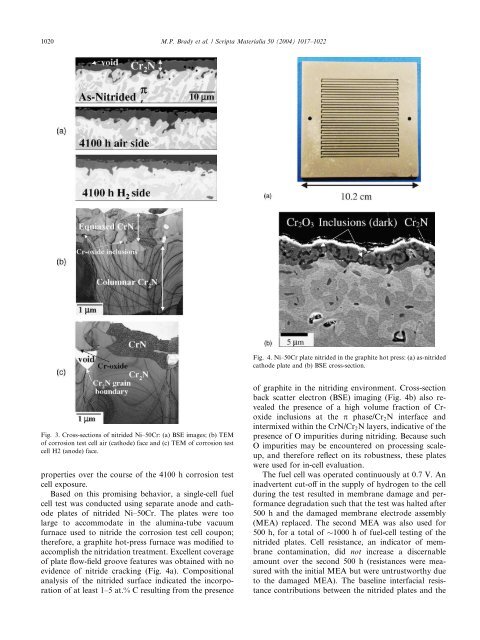Preferential thermal nitridation to form pin-hole free - Oak Ridge ...
Preferential thermal nitridation to form pin-hole free - Oak Ridge ...
Preferential thermal nitridation to form pin-hole free - Oak Ridge ...
Create successful ePaper yourself
Turn your PDF publications into a flip-book with our unique Google optimized e-Paper software.
1020 M.P. Brady et al. / Scripta Materialia 50 (2004) 1017–1022<br />
Fig. 3. Cross-sections of nitrided Ni–50Cr: (a) BSE images; (b) TEM<br />
of corrosion test cell air (cathode) face and (c) TEM of corrosion test<br />
cell H2 (anode) face.<br />
properties over the course of the 4100 h corrosion test<br />
cell exposure.<br />
Based on this promising behavior, a single-cell fuel<br />
cell test was conducted using separate anode and cathode<br />
plates of nitrided Ni–50Cr. The plates were <strong>to</strong>o<br />
large <strong>to</strong> accommodate in the alumina-tube vacuum<br />
furnace used <strong>to</strong> nitride the corrosion test cell coupon;<br />
therefore, a graphite hot-press furnace was modified <strong>to</strong><br />
accomplish the <strong>nitridation</strong> treatment. Excellent coverage<br />
of plate flow-field groove features was obtained with no<br />
evidence of nitride cracking (Fig. 4a). Compositional<br />
analysis of the nitrided surface indicated the incorporation<br />
of at least 1–5 at.% C resulting from the presence<br />
Fig. 4. Ni–50Cr plate nitrided in the graphite hot press: (a) as-nitrided<br />
cathode plate and (b) BSE cross-section.<br />
of graphite in the nitriding environment. Cross-section<br />
back scatter electron (BSE) imaging (Fig. 4b) also revealed<br />
the presence of a high volume fraction of Croxide<br />
inclusions at the p phase/Cr2N interface and<br />
intermixed within the CrN/Cr2N layers, indicative of the<br />
presence of O impurities during nitriding. Because such<br />
O impurities may be encountered on processing scaleup,<br />
and therefore reflect on its robustness, these plates<br />
were used for in-cell evaluation.<br />
The fuel cell was operated continuously at 0.7 V. An<br />
inadvertent cut-off in the supply of hydrogen <strong>to</strong> the cell<br />
during the test resulted in membrane damage and per<strong>form</strong>ance<br />
degradation such that the test was halted after<br />
500 h and the damaged membrane electrode assembly<br />
(MEA) replaced. The second MEA was also used for<br />
500 h, for a <strong>to</strong>tal of 1000 h of fuel-cell testing of the<br />
nitrided plates. Cell resistance, an indica<strong>to</strong>r of membrane<br />
contamination, did not increase a discernable<br />
amount over the second 500 h (resistances were measured<br />
with the initial MEA but were untrustworthy due<br />
<strong>to</strong> the damaged MEA). The baseline interfacial resistance<br />
contributions between the nitrided plates and the

















